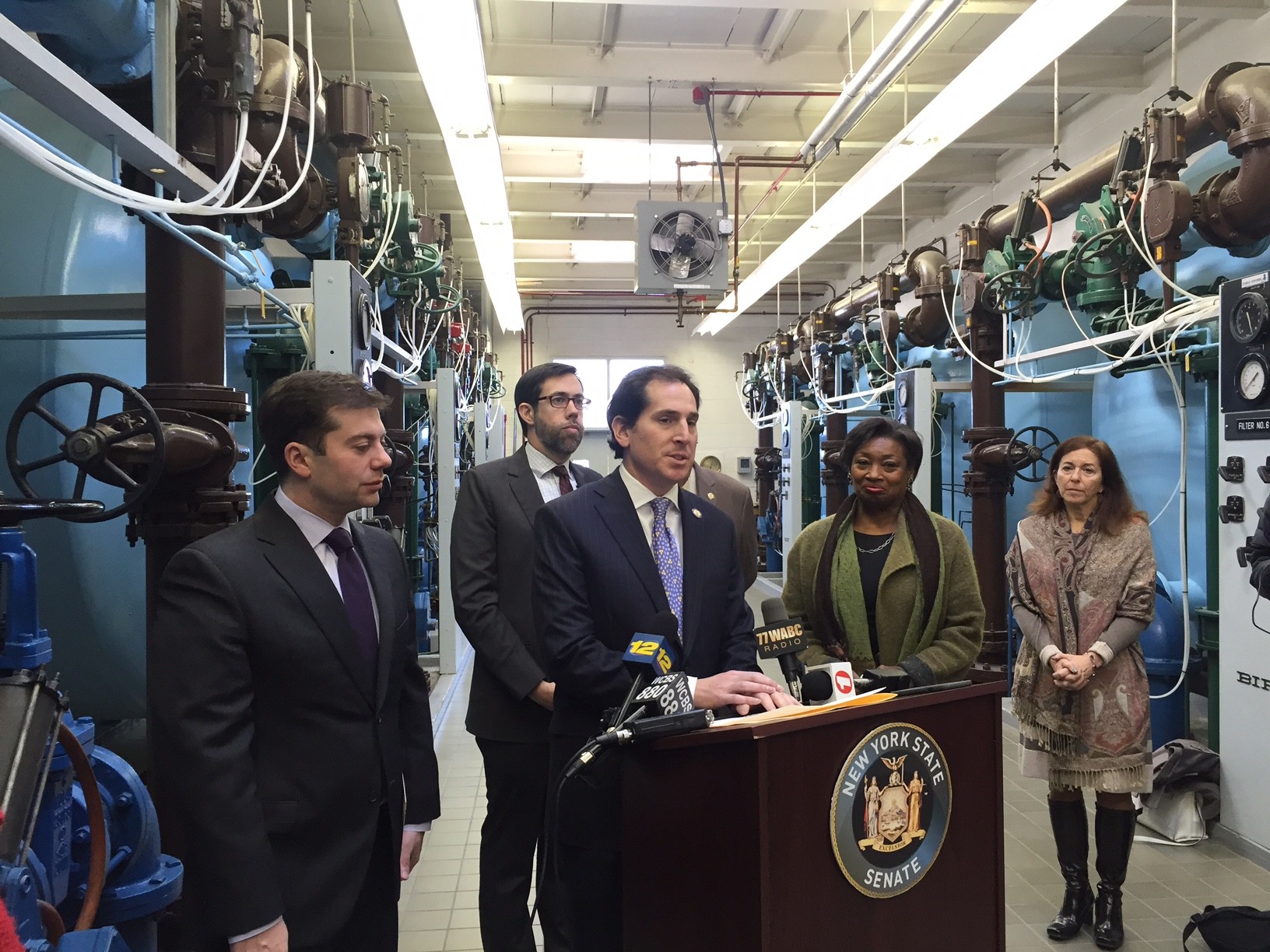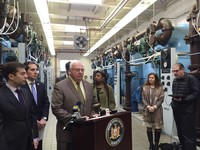Thursday, April 18, 2024
Senators fight to protect New York’s drinking water
Announce legislation to expand testing and regulate contaminants
A group of Democratic state senators announced comprehensive legislation last week aimed at protecting the quality of New York’s water following a report that concluded that water supplies on Long Island and around the state have been contaminated with toxic chemicals linked to cancer; that aquifers like the Lloyd are at risk of saltwater intrusion; and that crumbling infrastructure is threatening residents’ health.
State Sen. Todd Kaminsky, Democratic Senate Minority Leader Andrea Stewart-Cousins, Senators John Brooks and Daniel Squadron and Long Beach City Manager Jack Schnirman held a news conference on Feb. 16 at the city’s water purification plant to announce a seven-point plan that they said would protect water resources statewide.
Officials said that a third of New Yorkers are drinking water that isn’t fully tested. If approved, the series of bills would include expanded testing for toxic chemicals and establish regulations for contaminants.
“In light of disturbing news about chemicals found in the water on Long Island and across New York state, governments need to move aggressively,” said Kaminsky, the ranking member of the Senate’s Environmental Conservation Committee, who is leading the initiative. “We’ve seen what happened in different parts of our country when we let the problem get ahead of us when it comes to water. When we see other states taking regulatory action … we in New York know that we need to lead on this as well.”
The news conference was held a day before the U.S. Senate confirmed Oklahoma Attorney General Scott Pruitt, a staunch opponent of the Environmental Protection Agency, as head of the organization, as President Trump looks to remove major EPA regulations on climate change and clean water, according to The New York Times.
“As the federal government moves toward abandoning environmental protection, we need state elected officials to rescue environmental protection,” said Adrienne Esposito, executive director of Citizens Campaign for the Environment.
‘Un-poisoning the well’
According to a report by the Senate Democratic Policy Group called “Unpoisoning the Well: 7 Ways New York Can Better Protect Your Drinking Water,” in the past two years alone, drinking water supplies around the state have been contaminated with perfluorooctanoic acid, or PFOA, and perfluorooctanesulfonic acid, or PFOS — toxic chemicals linked to cancer that were also discovered in drinking water supplies in Suffolk County.
State drinking water sources have also tested positive for elevated levels of other likely carcinogens, including 1,4-dioxane — a chemical stabilizer used in a variety of chlorinated solvents, paint strippers, dyes, greases, and waxes — and the chemical chromium-6, the focus of the movie “Erin Brockovich.”
The report said that the state does not specifically regulate those chemicals in drinking water. Earlier this month, Gov. Andrew Cuomo called on the EPA to establish an official drinking water standard for 1,4-dioxane, and said that the state would set a limit if no action were taken in three months.
Rather than waiting for the EPA to act, however, the senators called on the state to set limits on PFOA, PFOS and other chemicals.
Currently, there is no national drinking water standard for 1,4-dioxane, leaving the state standard at the default level for unregulated contaminants of 50 micrograms per liter, according to Kaminsky’s bill, which would set limits on the chemical. In 2014 the EPA identified 1,4-dioxane as a likely carcinogen and set a health reference guideline for lifetime exposure at a much lower .35 micrograms per liter.
Officials said that recent testing has shown high levels of 1,4-dioxane in 71 percent of water districts tested on Long Island, compared with 7 percent nationwide.
The EPA has set the federal standard for total chromium in drinking water at 100 parts per billion, officials said, though the agency has never set a specific limit for chromium-6. Brooks’s legislation called for the state Department of Health to conduct a review of the chromium-6 in public water supplies and establish a maximum contaminant level.
Brooks told reporters that in Nassau County alone, 27 out of 28 public water systems have tested positive for chromium-6, with an average level of .338 parts per million, compared with California’s limit of .02 parts per million. A spokeswoman for the county's Health Department did not immediately respond to a request for comment.
“We’re witnessing a serious problem across the state and here on Long Island with water contamination,” Brooks said. “It’s critical that we establish maximum limits and thresholds on chromium-6 and other chemicals if we are going to protect our residents and water system in the future.”
Schnirman and other officials emphasized that the drinking water in Long Beach is safe, especially after the city spent millions of dollars upgrading the plant after Hurricane Sandy. Last year the city issued a report on the quality of its drinking water after it conducted thousands of tests for more than 130 different contaminants, including chromium, which were undetected.
Stewart-Cousins said that three million people on Long Island share only three major aquifers. The report noted that the Lloyd Aquifer — the oldest and deepest — is vulnerable to saltwater intrusion. With the “EPA under threat,” the report recommended that the state establish an Office of Water Safety to address saltwater intrusion and other contaminants in water resources.
The report also calls for increased funding for infrastructure upgrades, as well as expanding water testing for lead in schools and day-care centers.
“I think whether you’re a Democrat or a Republican … in these next few months, I am confident that we are going to be able to do something about this,” Kaminsky said.
HELP SUPPORT LOCAL JOURNALISM
The worldwide pandemic has threatened many of the businesses you rely on every day, but don’t let it take away your source for local news. Now more than ever, we need your help to ensure nothing but the best in hyperlocal community journalism comes straight to you. Consider supporting the Herald with a small donation. It can be a one-time, or a monthly contribution, to help ensure we’re here through this crisis. To donate or for more information, click here.
Sponsored content
Other items that may interest you











